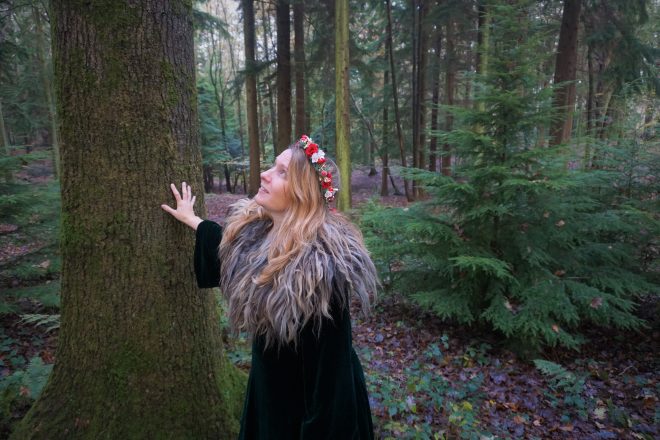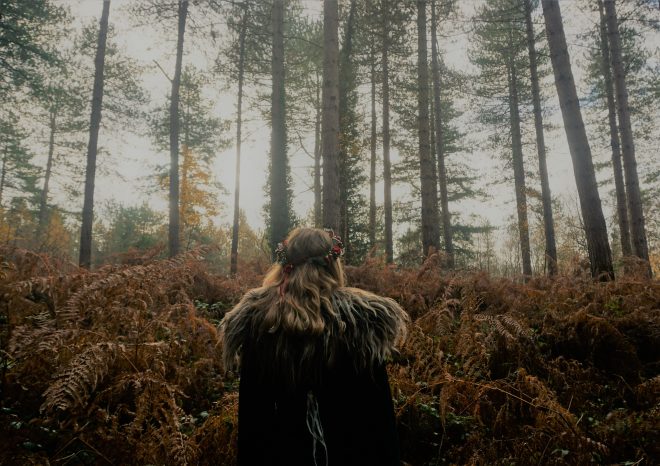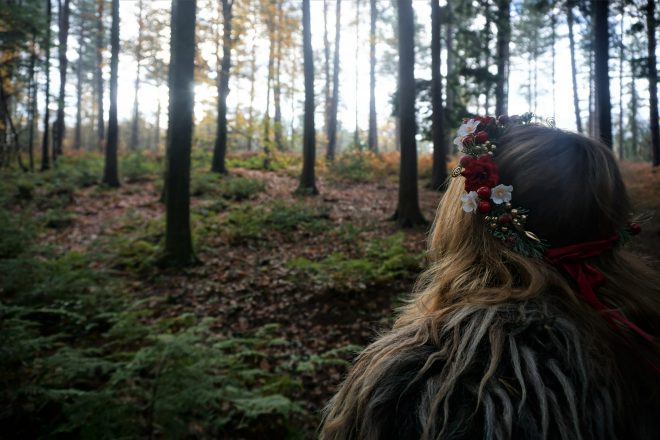‘Twas the night before Christmas in the South Downs!
December 6, 2022

It’s a cold winter’s day and the north wind whistles through the valleys of the South Downs as mossy trees sway in a merry dance.
Emerging from the forest is a flame-haired, green-gowned woman with a story. It’s a tale that has stood the test of time.
Yet this is no fairy, wise woman, elf, or Mother Christmas – it’s the National Park’s very own storyteller Dawn Nelson!
 Dawn, who is Place and Interpretation Officer for the National Park, is sharing some of her favourite festive folklore and has produced three short films that are guaranteed to put you in the Yuletide mood!
Dawn, who is Place and Interpretation Officer for the National Park, is sharing some of her favourite festive folklore and has produced three short films that are guaranteed to put you in the Yuletide mood!
Dawn says: “Wintertime has so many ancient traditions and tales. It was a time when communities would gather round the hearth and listen to age-old tales of wisdom, good fortune and superstitions and, in many ways, these yarns would see you through the cold, dark months.
“There are stories aplenty in the South Downs, many of them instrincally connected to this enchanting landscape of woodland, valleys, rivers and cliffs. They are not quite as scary as some around the world though, such as Iceland’s Yule Cat or the Alpine region’s terrifying Krampus, scaring children into good behaviour! I hope people enjoy listening to this local folklore and feel inspired to venture out and discover more tales of the winter woodland.”
Kings of the Winter Wood
Each year the light waxes and wanes.
In the summer we have the longest days and in the winter we have the shortest. There are some Kings of the winter woodland that ensure that the light and the dark are kept in balance.
These kings are the Oak King and the Holly King. On each solstice night they do battle to see which will hold the light for the coming season.
In June, the Holly King takes the light from the Oak King and holds it behind the sharp dark green leaves as the days get shorter.
Finally they do battle again for the winter solstice between 21 and 23 December.
During this battle the Oak takes back the light and sends it out into the world so that the days from this point forward start to get longer.
So next time you see an oak and a holly standing together, you know why that is!

Magical Mistletoe
Mistletoe, despite its festive appeal, is in fact a parasitic plant. An unwelcome visitor for the host tree but this didn’t stop it from gaining a reputation as a sacred plant with the druids of old. An ancient tradition involved a druid in a white gown harvesting the mistletoe with a golden sickle in order to perform a ritual that would bring fertility and prosperity for the coming year. A young person from the village would be sent around the streets with the bough of harvested mistletoe to see in the new year.
It wasn’t until the 18th century that mistletoe became a yuletide favourite. Before that, mistletoe was hung above the door because folk magic, the old ways of our ancestors, told that it offered protection, representing peace and hospitality. The sprig of mistletoe stayed in place all year in order to ensure this good luck held until a new sprig was placed there in the new year. It was even said to have the power to prevent nightmares.
On the subject of dreams, it is said that if you place a leaf of mistletoe beneath your pillow at night you will dream of your true love.
Wassailing the Year
Wassail and to your good health!
During the winter the trees are bare and when we did not have the convenience of supermarkets we would have been pickling and preserving the last of the year’s crops. Then our thoughts would have turned to the next season, what to plant and whether or not it would be prosperous.
There are many traditions that bless crops and one of these is wassailing. Wassail is the old English word for good health or good cheer and to wassail the apple orchards in the new year is a tradition that stretched backed to the 15th century and still goes on today.
To wassail the apple trees you will need a cup of ale and a local orchard. Gather together, sing to the trees and make offerings of the ale to ensure a good harvest of apples the following autumn. This event traditionally took place on Twelfth Night or Old Twelvey as it used to be known. This used to fall on 17 January but with the introduction of the Gregorian calendar, it now falls on 5 or 6 January depending on how you count the days. Wassailing originates from the West Country but these days there are wassailing events up and down the country.
Don’t wait for Twelfth Night, just go sing to the apple trees but of course, do make sure, if they are not your apples that you have the landowner’s permission!
Wassail, wassail to our town
The cup is white and the ale is brown
The cup is made of the ashen tree
and the ale is made from good barely

